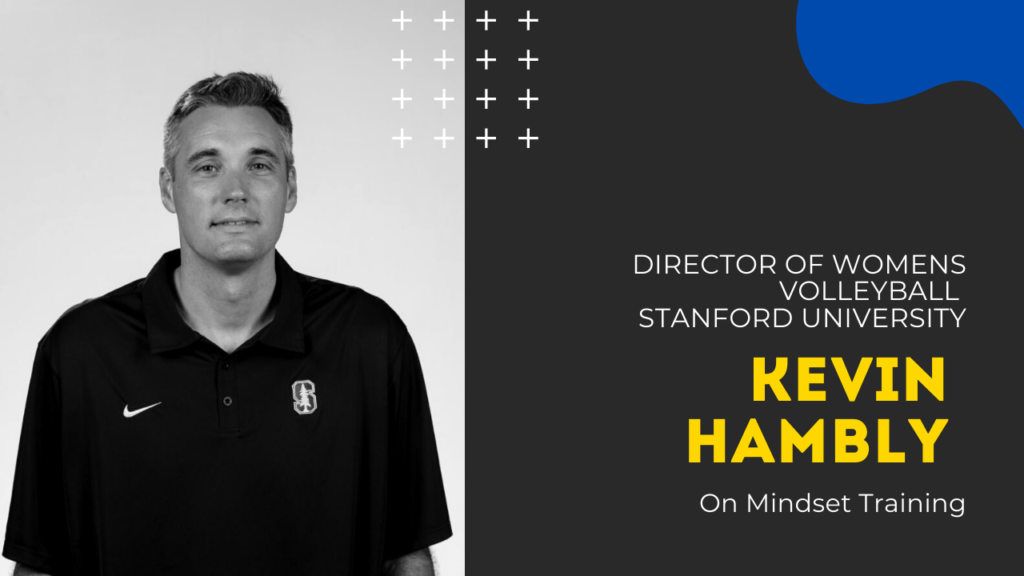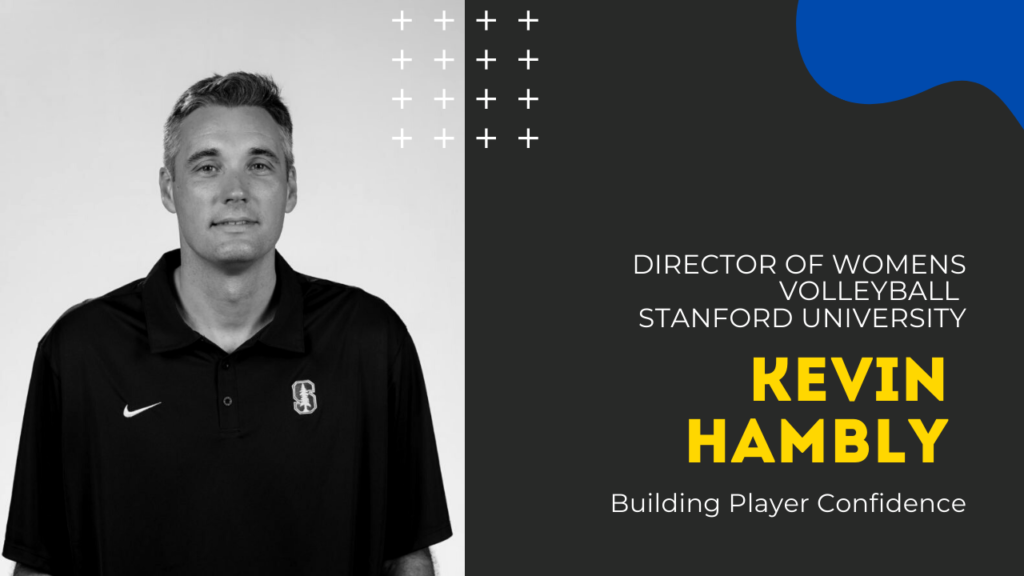After inheriting the program in 2017, Kevin Hambly led the Cardinal women’s volleyball program to back-to-back NCAA national titles. In 2018 he was named the Pac-12 and AVCA Pacific North Region Coach of the Year. Prior to taking the helm as the Director of Women’s Volleyball at Stanford, he was the head coach at Illinois for eight seasons, where he led the Fighting Illini to six NCAA regional appearances and the 2011 national championships.

What does the Stanford women’s volleyball team do for mindset training?
We do a lot of stuff that we work on individually. We see what the needs are of the individuals. We talk a lot about confidence. Confidence is where the training and the mindset intersect. If you put the time in, you can develop confidence. The other things that we talk about (are) mindfulness and finding your center. We talk about breathing. We do some meditation training. The thing that we talk directly about as far as competing on the floor is; being aware of where your thoughts in competition, being aware of where your thoughts are in practice and if they are negative thoughts, replacing those thoughts. We talk a lot about thought replacement and being aware of (what) you’re thinking. Replace the thought “I can’t do this” with – “I can do this. I am strong. I am powerful. I got this.” We talk a lot about that thought replacement.

We talk a lot about confidence. Confidence is where the training and the mindset intersect. If you put the time in, you can develop confidence.
What type of strategies do you use to help players rebound when they have a crisis of confidence?
To me that’s very individualized and it depends on the athlete. For some of them I feel like we try to get ahead of it a little bit. One of our athletes last year was new to us and she was struggling with confidence early on. I think she was trying to decide if she could fit in the team or not. She was struggling to learn our system and all that. One of the things we talked about is how do you earn the confidence first and understand that there’s going to be this learning curve. That’s the 1st piece, giving her perspective. You’re learning a whole new system, you’re playing with new players and you’re trying to figure all this out. Just take a deep breath and be committed to the process.
I feel like my athletes are very pragmatic, they over analyze, and so if we can find the things that are necessary for them to compete and they attack those things in practice or with a little bit of extra time then usually that takes care of a lot of it. She was a middle blocker, so for her (it looked like) getting extra footwork reps, a few more slide reps, or working on a shot.
And having a conversation – this is how it looks like this team is going to defend you, or this is how they defended you last time. We’ve done that same strategy with passers that have struggled or setters that have struggled. Instead of just saying you should have confidence, get those reps because then they feel like they’re earning the confidence. By mitigating their feelings and just saying what you’re feeling is wrong doesn’t really help them. Let’s try to give them perspective first and then let’s see if we can earn that confidence.
That’s worked out for most of our athletes actually. It’s like if they want to get an A in the class, then they’re going to study and put the time in. That’s how they’re going to have confidence on their tests. We try to draw those parallels. The challenge for all of them is trying to find that perspective. It’s the perspective that it’s okay to make mistakes right now. This is part of the process. We only care about being good in December.

When you have a team that is very diverse and full of different personalities, how do you approach team building and leadership?
I do my best to try to recognize leadership. Everyone talks about developing leadership, but I feel like we recognize leadership. We have to recognize who the leaders are first. We don’t have a captain on our team. We have a floor captain. We just say whoever is setting is our captain, but that doesn’t mean they’re necessarily our leader. We try to figure out what things we value as a group and what are our goals as a group. As you start to have those conversations the vocal leadership starts to emerge. I pay attention to that and identify the leaders. Once I identify who the (natural) leaders are, then I try to put as much on those guys to help drive the culture and the cohesiveness as much as possible because I feel like it’s always stronger when it’s coming from the athletes.
My leadership style as a head coach, even with my staff, is to identify what people are really good at. I’m going to give you the freedom to explore those things as a recruiter, as a coach, as the competitive leader, as the task leader or as the social leader. Let’s identify what you are. Let me be a resource to help you be the best version of that leader possible and what this group needs from you. And then empower you and amplify the message. As a teacher I need to teach our athletes what it means to be a leader, empower them to develop into successful leaders and to lead the way that we need them to and in the way the group is looking for them to lead.
How do you teach communication on your team?
The most important part of communication from me and from my athletes is we’ve got to listen. When freshman come in, they don’t listen to anybody unless you scream and yell. They just want to communicate. The first step for us is we have to listen to each other. But also, if you want people to listen to you, you have to know how to communicate concisely so you don’t lose them in the conversation. And so we talk pretty openly about that. We say – be direct, be on point, be on topic and be concise with that communication in every single way. As the person that’s communicated to, let’s make sure we listen and acknowledge. Just that, (learning to) listen and acknowledge, makes us better communicators in every single way. That goes for if it’s a text I send to the group, they all acknowledge it, they all send a little thumbs up emoji or a got it, or whatever. We give them the freedom to create their own language but with these rules, you’re going to communicate concisely and receive the communication. In this world where we communicate so much through text messages, I think the acknowledgement piece and the listening piece are lost.
What type of pre-game routine do you have in your program?
I leave that up to the athletes. I would not say that we have a routine. I would say that finding a routine that works for each individual is absolutely important. You need to figure out how to prepare yourself physically, mentally and emotionally so you can play in the national championship. And then also you need to figure out how to get your head right for each match. It’s going to take practice and you gotta figure that out. And so we’d talk about that as a group. How do you get yourself ready for competition? How do you eliminate everything that’s around you and get yourself in this moment right now?Different teams have had different strategies. One group shut everything down, turned their phones off, and (found) a quiet place to meditate or breathe, but with my team last year it was like dance party. Goofiness got them in the right place because that helped them let go of everything else.
Dig Deeper
Listen to Kevin Hambly talk about mindset training, earning confidence, team building and leadership on Headstrong’s YouTube channel.
For more strategies and tools for team building and developing player confidence grab a copy of the Headstrong Mindset training book for volleyball teams. You can also download the free workbook which includes activities and resources for building player confidence.